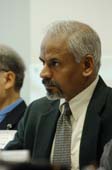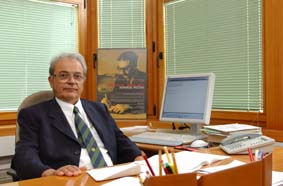Personal tools
News from ICTP 102 - Features - Bridge Between

Acting director Erio Tosatti outlines his goals for his brief 10-month tenure, which will end in March with the arrival of Katepalli R. Sreenivasan.
A Bridge Between
Erio Tosatti
Between Miguel Virasoro's retirement
last May and the arrival of ICTP's new director, Katepalli R.
Sreenivasan, this coming March, the Centre finds itself in a state
of transition.
As the person who has been called--coaxed might be a better word--to
stand at the helm of ICTP during this transition, I have felt
a bit like a flimsy bridge perched across two massive tectonic
plates.
Sure enough, there is no deadly crevice beneath us--no immediate
cause for apprehension. Virasoro left ICTP in excellent shape.
New in-house research groups in the physics of weather and climate
and in statistical mechanics are flourishing. So are the capabilities
of ICTP to meet its training mission in these new critical areas
as well as in our more traditional disciplines.
Funding is in good shape, thanks mainly to the support of the
Italian government, which has been both generous and foresightful
in its policy towards developing countries and, more specifically,
in providing young scientists from the South with broad opportunities
to pursue their research interests with the resources and dignity
that they deserve.
ICTP's infrastructure has been expanded and refurbished. Extensive
renovations in the Adriatico Guesthouse have given the Centre
ample new lecture rooms. The computerisation of administrative
services is now complete and a new state-of-the-art system will
soon be in operation allowing all lecture material from ICTP's
training sessions to be placed directly on the web.
A dozen new scientific staff posts were recently opened and widely
advertised for selecting not just the best brains available worldwide
but the most motivated and giving among them--and several of these
posts have already been filled. New scientific staff should boost
our relevance and improve our ability to help developing world
scientists even more.
Meanwhile, the Centre's staff continue to perform their tasks
in quiet efficiency, enabling ICTP to carry on its many training
and research activities as smoothly as a well-oiled machine.
All of these factors have helped to create an institution that
many others envy. More importantly, these elements provide a very
solid tectonic plate on which to face the future.
So, where do the fault lines lie? What are the gaps that an acting
director must straddle until the next full-fledged director--the
next tectonic plate--arrives?
Not surprisingly, despite all the good things, there are some
troubled waters to bridge and gnawing gaps to fill. There are
indeed important things to do that should not wait.
Here are a few immediate priorities that have stood in front of
me and that I have tried to broach during my brief tenure.
The first is to refresh and revitalise contacts with the three
parties that oversee the Centre: the United Nations Educational,
Scientific and Cultural Organization (UNESCO), the International
Atomic Energy Agency (IAEA), and the Italian government.
UNESCO provides the framework for nearly all our administrative
functions. Because it is neither a scientific nor an academic
institution, it must literally stretch its rules to accommodate
some of our unusual procedures. The Centre, in turn, must stretch
to fit into UNESCO's rules as best it can, while still being able
to function well.
These simultaneous stretching exercises have become more synchronised
with the welcome visit to ICTP of UNESCO's head of human resources
management, Dyane Dufresne-Klaus. On the science and training
side, we are now opening new channels of co-operation with UNESCO's
natural sciences sector, headed by Walter Erdelen, most notably
through contacts with Maciej Nalecz and Minella Alarcon in the
basic sciences programmes.
Relations with IAEA, the Centre's alma mater until 1996,
which have always been close, are becoming still closer, due to
many joint training activities now taking place at ICTP. I have
met with Werner Burkart and Hadj Slimane Cherif of IAEA at the
Centre and attended the Agency's General Conference this September
in Vienna to discuss additional avenues of cooperation.
The Italian government, the third party in the tripartite agreement
that guides ICTP, has been kept well informed of our initiatives
through continual contact with Nicola Cabibbo, the government's
liaison with the Centre, as well as through frequent discussions
with Aniello Izzo and Gioacchino Fonti, representatives of the
government's research and treasury ministries, together with counsellor
Enrico Vicendi.
Italy, however, also deserves to be informed of what ICTP is doing,
within the Centre's mandate, that may be of real or potential
value to the country. Francesco Caruso, Italy's ambassador to
UNESCO; Claudio Moreno, Italy's ambassador to IAEA; and Francesco
Aloisi de Larderel, director general, Department of Cultural Promotion
and Cooperation of Italy's Foreign Ministry, have been kept abreast
of our initiatives and invited to ICTP. A recent visit by Harald
Kreid, director general, Central European Initiative (CEI), also
provided an opportunity to raise relevant issues concerning the
Centre's relationship with its host country and major funder.
We should intensify informal as well as formal contacts and, in
fact, do everything we can to make our activities more visible
to the public: in Trieste, the city that so graciously hosts us;
in Italy, the country that so generously funds us; and throughout
the world so that we may more effectively attract young, still
unknown scientists in the South striving in isolation, to whom
we could lend a helpful hand if only we knew of each other's existence.
That is why I believe our celebration of UN Day in October was
such an important event. It helped us to re-establish our ties
with local Italian officials and, at the same time, gave us an
opportunity to tell our story to a larger public, including national
government leaders, through the media.
I would also like to hand over to our new director an institution
that enjoys a greater sense of unity. More unity can be achieved
by examining decisions together before making them, delegating
more effectively, and informing staff about what is to come, good
or bad, so that new things will not be perceived, as so often
happens when one neglects to inform, as being imposed from above.
Finally, I should like to do something for science at ICTP. After
all I am--and will always remain--a scientist.
Ever since I came to Miramare a quarter of a century ago, ICTP
has been a good, sometimes excellent, place for analytical theoretical
physics--science done with paper and pencil. But it has always
been a lesser place for computational theoretical physics--science
that needs computers and supercomputers to crunch numbers.
The reason for this disparity goes back to the founding of ICTP
by Abdus Salam and Paolo Budinich: both elementary particles physicists
who pursued abstract questions and theories that did not require
computers for their work. That Roberto Car and Michele Parrinello
invented here their celebrated computational method, struggling
in 1984 with the terribly inadequate machines that ICTP provided
them with at the time, is merely a tribute to their ingenuity.
Today ICTP does have computers but not of the type, power, and
speed needed to conduct serious computational physics. Even colleagues
from the Third World grin when they note the superiority of their
facilities at home. Because ICTP is now developing strong computational
research lines in condensed matter physics and in the physics
of weather and climate, we have decided to take an important step
in remedying this computational deficit by acquiring in-house
supercomputer facilities.
The other thing I am doing for science at ICTP is to oversee,
as carefully as I can, the recruitment of new young staff scientists.
A restaurant is only as good as its cooks; a scientific institution
is only as good as the people it can attract. If ICTP were to
become a haven for second-class scientists, it would seriously
erode its standing within the global scientific community and,
consequently, its ability to attract the best scientists from
both the North and South, who meet and collaborate here.
The thrill of being able to do creative science is a real possibility
for every young man or woman with talent. But for that possibility
to become a reality, first-class teachers and mentors are essential.
Recruitment of talented young scientists with great potential
for future accomplishments and with a gift for giving is what
I am striving for in filling ICTP's new scientific posts. I believe
such efforts will help advance the ideals of the Centre's founders,
Abdus Salam and Paolo Budinich. Le Dung Trang, Marcelo Osvaldo
Magnasco, Matteo Marsili and Sandro Scandolo, who have all been
hired during the past six months, represent critical steps for
ensuring a brighter future for the Centre.
I can think of no better way of serving as a sturdy bridge between
Miguel Virasoro, who left in May, and Katepalli R. Sreenivasan,
who will arrive in March.
Erio Tosatti
ICTP Acting Director

Katepalli R. Sreenivasan, born in India and now a citizen
of the United States, has been appointed the new director of the
Abdus Salam International Centre for Theoretical Physics. The
announcement was made by Walter Erdelen, UNESCO Assistant Director
General for Natural Sciences, at the ICTP Scientific Council in
Trieste, Italy, on 4 November.
Sreenivasan is a world renowned experimental physicist whose major
fields of interest are fluid dynamics and turbulence. He is currently
a professor of physics and mechanical engineering at the University
of Maryland in the United States, where he also directs the Institute
for Physical Science and Technology.
Sreenivasan, 55, received his education in India, first at the
University of Bangalore and subsequently at the Indian Institute
of Science, Bangalore, where he earned a doctorate in aerospace
engineering in 1975. Following two years of post doctoral study
in Sydney and Newcastle, Australia, he travelled to the United
States to serve as a researcher at Johns Hopkins University in
Baltimore, Maryland, and then at Yale University in New Haven,
Connecticut, where he was the Harold W. Cheel professor of mechanical
engineering and professor of physics, applied physics and mathematics.
He moved to the University of Maryland last January.
Sreenivasan has numerous publications to his credit in such fields
as turbulence, complex fluids, combustion, cryogenic helium and
nonlinear dynamics. He is scheduled to begin his tenure at ICTP
in March next year.
